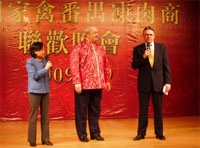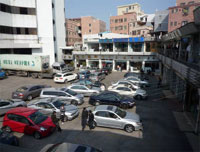



USAPEEC Banquet Honours Chinese Poultry Traders
CHINA - On 9 January, the US Poultry & Egg Export Council (USAPEEC) hosted a reception dinner in Guangzhou for invaluable Chinese traders of US poultry products from around the country. So far, Chinese imports of US poultry in 2008 have been significant but traders are extra cautious about 2009.On 9 January, the USAPEEC headed by its president, James Sumner, and Sarah Li, Country Director, hosted a reception dinner in Guangzhou in appreciation of the invaluable Chinese traders of US poultry products from around the country. Over 700 guests consisting of US poultry exporters and Chinese importers as well as USDA/FAS officials including Bill Westman/OAA, Michael Woolsey/OAA, Joani Dong/ATO Guangzhou, Phil Shull/ATO Hong Kong and David Kiefner/ATO Shanghai participated.

Background
Uncertainty about 2009. Latest China Customs data indicates that from January to November 2008, China imported 761,610 tons of poultry products valued US$1.0 billion. The States sent over 555,703 tons or 73 per cent of the total valued US$738 million. Most US products were chicken paws, followed by leg quarters and drumsticks, wingtips, chicken wings, turkey products and gizzards. 70 per cent of imported poultry cleared Guangdong ports such as Shenzhen port and Guangzhou port. Poultry imports from the state of Arkansas are still banned because of a previous AI case in June 2008. In 2007, imports from the States were 534,284 tons valued US$612 million.
It is important to note insiders believe 2008 data reflects a large percentage of imported products still in stock because of recent low prices. Understandably, traders’ lack of confidence in the 2009 market makes them hesitant to order big quantities for the rest of the year. According to James Sumner, the President of USAPEEC, US poultry production could decline by 6 per cent for the first half of the year.

A trader is a gambler. According to interviewed Chinese importers, most (95- 98 per cent) traders suffered 20-30 per cent profit losses in 2008 as Chinese pork and poultry production increased in the second half of the year so imported poultry wholesale prices plummeted. Given increased feed costs, depressed US domestic demand and low export prices, US poultry farms and exporters also suffered losses. The largest US exporter, Pilgrim’ s Pride, has filed for bankruptcy protection. Nevertheless, its processing plants will stay in operation. The impact to industry and exports should be limited.
| Current FOB prices (US$ per pound) are: | |
| Paws (small): | 0.40-0.50 |
| Drumsticks: | 0.50-0.55 |
| Paws (large): | 0.70 |
| Leg Quarters: | 0.28-0.38 |
In 2009, traders will reduce orders. An interviewed trader claimed that he plans to cut orders by half from 600 containers to 300 containers per month. Many traders rely on “import declaration companies” to import and clear customs on their behalf. There are 73 Chinese companies which have poultry import quotas appropriated by the Ministry of Commerce (MOFCOM) as a means to control competitively priced imports. However, it is said that only 40 actually use quotas to import for themselves or for others. The rest just sell their quotas at RMB200-250 (US$29-37) per ton to those without quotas. One trader said he was more concerned about getting enough quota than about price fluctuations. Outside of these 73, there are said to be 400-500 importers in China, 200 of which conduct business at Daluotang Wholesale Market in Guangzhou, the biggest for frozen poultry in China.

Salmonella. The importers claimed that only one to two percent of imports were found with salmonella. If found, they would need to pay for irradiation costs, said to be about US$3,000 per container. This percentage could increase when US and Chinese governments have a sour relationship. Some believe the Chinese government will impose stricter grey channel controls, but the problem is China is immense and the border, too long. China has 0 tolerance for salmonella. Cooking poultry automatically kills the bacteria although food handlers may still transmit.
Competition. There are Brazilian, Argentine and European poultry products smuggled into China via Vietnam. Rumors suggest 23 Brazilian plants are about to be allowed to enter China in 2009. In such case, US products will face strong competition because Brazilian ones are preferred due to cheaper prices, equal amount of meat compared to American product, less moisture because of air blast freezing system in processing, better appearance, thanks to lower labor costs that enable hand cutting. Argentine products - paws in particular - are less competitive because they tend to be bonier.
Individual importers also face challenges when large state-owned companies such as COFCO, import large amounts of frozen pork with subsidies from the government. In 2009, prices of imports will be squeezed as the Chinese government continues to subsidize domestic livestock production and the meat processing industry.








